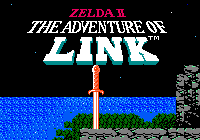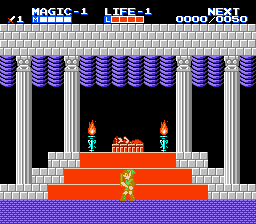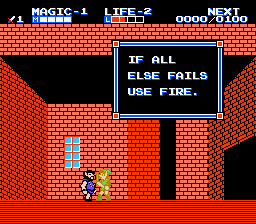|
|

|
PLATFORM
|
NES
|
BATTLE SYSTEM
|

|
INTERACTION
|

|
ORIGINALITY
|

|
STORY
|

|
MUSIC & SOUND
|

|
VISUALS
|

|
CHALLENGE
|
Hard
|
COMPLETION TIME
|
Less than 20 Hours
|
|
OVERALL

|
+ Technically the only Zelda RPG.
+ Some strategy in combat.
- Very easy to die in some areas.
- Repetition after dying can be annoying.
- Has dialogue such as I AM ERROR.
- Hasn't aged well.
|
Click here for scoring definitions
|
|
|
After Link destroys Ganon, a sleeping spell was cast on Princess Zelda, and only the power of the Triforce of Courage can awaken her. However, the Triforce is sealed in a palace in Hyrule, and Link must place six crystals in statues in different palaces across the land in order to break the seal. Nintendo's Zelda II: The Adventure of Link is the direct sequel to The Legend of Zelda, featuring drastic gameplay changes from its predecessor and being unique in the franchise even today. However, while the sequel has some things going for it, it can, like its predecessor, be especially frustrating to modern gamers, and hasn't aged particularly well.
Among the major changes is that Zelda II features side-scrolling gameplay in many areas akin to other titles such as Metroid and Castlevania, unlike its top-down predecessor. However, the sequel does feature a top-down overworld connecting towns, dungeons, side-scrolling fields, and some occasional secret areas. As Link wanders about, enemies will appear after a few seconds and pursue him; touching one of them will take the player to a side-scrolling screen, which may have nothing, enemies, or an HP-recovering fairy.
In side-scrolling mode, Link has a sword and a shield, and can jump. Link can naturally attack enemies with his sword, and when his health his full, his sword will fire a small laser. In all other instances, though, Link, given the dinky range of his sword, must draw close to the enemy to damage them and attempt to kill them. Enemies will naturally try to fight back, although Link's shield can block most projectiles they toss his way. The A.I. of many enemies is surprisingly good for an 8-bit game; for instance, trying to jump past a few will result in them walking backwards, and enemies with shields will constantly block Link's attacks, although jumping and slashing them right before landing will normally damage them.
Link also has an MP gauge, with sages in many towns giving him a variety of spells to cast (in addition to upward and downward stabs that can enhance melee combat), such as Shield, which increases defense, and wears off when the player goes to a different screen. Another spell allows Link to shoot fireballs with his sword slashes, and is in fact necessary to kill certain foes, again wearing off whenever the player goes to a different screen. Yet another spell that can be useful is healing magic that restores three squares of Link's health. Enemies will rarely drop potions that either heal one square of his MP or restore his MP completely.
 Sleeping Zelda gives Link dirty thoughts
Sleeping Zelda gives Link dirty thoughts
|
|
Unlike in other Zelda games, moreover, killing enemies actually gives Link experience, allowing him to level up occasionally, in which case his attack power, health, or magic will increase. The player can also find special items that lengthen his health and magic bar by one square, letting Link sustain more damage and cast more magic. Another thing to consider is that Link has three lives, and losing all HP or falling into a pit will cost the player a life. If Link loses all his lives, it's Game Over, with the player able to continue at the starting palace where Zelda sleeps or save and quit the game, but all experience acquired to the next level is lost. The player may rarely find extra lives, although these permanently disappear in the current playthrough.
Given the increased space for combat, it's easier to get a handle of than in the first game, but the pitiful range of Link's sword can make it needlessly difficult at times, and some areas make it difficult for players to kill enemies without taking huge damage or expending large amounts of MP. As the game drags on, moreover, Link will have to walk great distances from the starting palace to whatever dungeon he needs to visit next, with these trips being able to easily drain his HP and MP, and in some cases lives (especially when falling into a pit is easy), so when the hardest parts of dungeons come, players can find themselves unprepared, get a Game Over, and have to repeat the aforementioned process. It's not an awful system, but the game can often feel cheap, since even the tiniest slipup can cost the player dearly.
As in the first game, Zelda II's menus don't get in the way, with only the magic menu to worry about, and the sequel is a little more linear, so finding out how to advance isn't as big of an issue, and townsfolk, despite the simplicity of their words, can actually be somewhat helpful. There are many things, however, that players certainly won't be able to discover without a guide (and which they may need, given the game's potential difficulty), and the dungeon design at times can cost players lives, but otherwise, interaction is half-decent, if nothing more.
Zelda II, to date, is the only installment of the series with side-scrolling gameplay, and definitely deserves points for creativity given its significant changes from the first game, and plenty of new features such as the magic system. It does feature elements from its prequel such as heart containers, Link, Ganon, and tools, but was definitely distinctive in its time.
 Link gets some advice from his political strategist
Link gets some advice from his political strategist
|
|
As in the first game, though, story is a nadir, with most of the plot coming from the text that eventually appears on the title screen after the player waits a while, indicating the sequel's connection to its predecessor and overlying goal. The story, however, doesn't receive any further development within the game, other than the fact that a Game Over results in Ganon's revival. NPC conversations don't add much to the story other than clues on how to advance, with the translation then showing its relative brevity with gems like I AM ERROR and SORRY, I KNOW NOTHING and SAFELY ENLARGE YOUR. As in pretty much every other game of the 8-bit era, story ultimately takes a backseat to the gameplay.
The music in Zelda II is okay and doesn't detract from the game, with some decent tracks such as an overworld theme that begins like the first game's but then delves into a different tune, and the dungeon theme. The sound effects are alright for an 8-bit game, although the soundtrack could have definitely used more diversity.
The graphics in the first Zelda sequel are a step above those in the original, with taller character sprites for Link and NPCs, even if many of the latter look similar. The various game environs such as forests, plains, and deserts, are reasonably discernable, although dungeons and many enemies are still more or less palette swaps. All in all, Zelda II didn't have the best visuals on the NES nor did it have the worst.
Finally, the sequel is about ten hours long, with this time largely including repetition because of death and occasional leveling, with a replay mode being available where the player retains Link's levels not to mention upward and downward stabs. In the end, Zelda II: The Adventure of Link does feature some improvements over its predecessor, such as with the gameplay and graphics, although it still somewhat falls flat, given its cheapness at times and unengaging plot, and like the first game hasn't aged particularly well. Even those more used to contemporary installments of the series might have a difficult time enjoying the second game.
Review Archives
|









